Host: Fraser Cain (@fcain)
Special Guest: Bas Lansdorp, CEO of Mars One
Guests:
Morgan Rehnberg (cosmicchatter.org / @MorganRehnberg )
Brian Koberlein (@briankoberlein)
Alessondra Springmann (@sondy)
Dave Dickinson (@astroguyz / www.astroguyz.com)
Continue reading “Weekly Space Hangout – April 24, 2015: Bas Lansdorp, CEO of Mars One”
Weekly Space Hangout – April 17, 2015: Amy Shira Teitel and “Breaking the Chains of Gravity”
Host: Fraser Cain (@fcain)
Special Guest: Amy Shira Teitel (@astVintageSpace) discussing space history and her new book Breaking the Chains of Gravity
Guests:
Morgan Rehnberg (cosmicchatter.org / @MorganRehnberg )
This Week’s Stories:
Falcon 9 launch and (almost!) landing
NASA Invites ESA to Build Europa Piggyback Probe
Bouncing Philae Reveals Comet is Not Magnetised
Astronomers Watch Starbirth in Real Time
SpaceX Conducts Tanking Test on In-Flight Abort Falcon 9
Rosetta Team Completely Rethinking Comet Close Encounter Strategy
Apollo 13 Custom LEGO Minifigures Mark Mission’s 45th Anniversary
LEGO Launching Awesome Spaceport Shuttle Sets in August
New Horizons Closes in on Pluto
Work Platform to be Installed in the Vehicle Assembly Building at NASA’s Kennedy Space Center in Florida.
Watching the Sunsets of Mars Through Robot Eyes: Photos
NASA Invites ESA to Build Europa Piggyback Probe
ULA Plans to Introduce New Rocket One Piece at a Time
Two Mysterious Bright Spots on Dwarf Planet Ceres Are Not Alike
18 Image Montage Show Off Comet 67/P Activity
ULA’s Next Rocket To Be Named Vulcan
NASA Posts Huge Library of Space Sounds And You’re Free to Use Them
Explaining the Great 2011 Saturn Storm
Liquid Salt Water May Exist on Mars
Color Map Suggests a Once-Active Ceres
Diverse Destinations Considered for New Interplanetary Probe
Paul Allen Asserts Rights to “Vulcan” Trademark, Challenging Name of New Rocket
First New Horizons Color Picture of Pluto and Charon
NASA’s Spitzer Spots Planet Deep Within Our Galaxy
Icy Tendrils Reaching into Saturn Ring Traced to Their Source
First Signs of Self-Interacting Dark Matter?
Anomaly Delays Launch of THOR 7 and SICRAL 2
Nearby Exoplanet’s Hellish Atmosphere Measured
The Universe Isn’t Accelerating As Fast As We Thought
Glitter Cloud May Serve As Space Mirror
Cassini Spots the Sombrero Galaxy from Saturn
EM-1 Orion Crew Module Set for First Weld Milestone in May
Special Delivery: NASA Marshall Receives 3D-Printed Tools from Space
The Roomba for Lawns is Really Pissing Off Astronomers
Giant Galaxies Die from the Inside Out
ALMA Reveals Intense Magnetic Field Close to Supermassive Black Hole
Dawn Glimpses Ceres’ North Pole
Lapcat A2 Concept Sup-Orbital Spaceplane SABRE Engine Passed Feasibility Test by USAF Research Lab
50 Years Since the First Full Saturn V Test Fire
ULA CEO Outlines BE-4 Engine Reuse Economic Case
Certification Process Begins for Vulcan to Carry Military Payloads
Major Advance in Artificial Photosynthesis Poses Win/Win for the Environment
45th Anniversary [TODAY] of Apollo 13’s Safe Return to Earth
Hubble’s Having A Party in Washington Next Week (25th Anniversary of Hubble)
Don’t forget, the Cosmoquest Hangoutathon is coming soon!
We record the Weekly Space Hangout every Friday at 12:00 pm Pacific / 3:00 pm Eastern. You can watch us live on Google+, Universe Today, or the Universe Today YouTube page.
You can join in the discussion between episodes over at our Weekly Space Hangout Crew group in G+, and suggest your ideas for stories we can discuss each week!
You Can Vote to Name America’s New Rocket from ULA
Help ULA name America’s next rocket to space. Credit: ULA
Voting Details below
Watch ULA’s March 25 Delta Launch Live – details below
Update 3/26: 2 new names have been added to the voting list – Zeus and Vulcan ![/caption]
United Launch Alliance (ULA) is asking the public for your help in naming their new American made rocket, now under development that “represents the future of space”- and will replace the firms current historic lines of Atlas and Delta rocket families that began launching back near the dawn of the space age.
Eagle, Freedom or GalaxyOne – those are the names to choose from for the next two weeks, from now until April 6.
UPDATE 3/26: 2 new names have been added to the voting list – Zeus and Vulcan !
ULA says the names were selected from a list of over 400 names submitted earlier this year by ULA’s 3400 employees and many space enthusiasts.
ULA has set up a simple voting system whereby you can vote for your favorite name via text or an online webpage.
Currently dubbed the “Next Generation Launch System,” or NGLS, ULA’s new president and CEO Tory Bruno is set to unveil the next generation rockets design and name at the National Space Symposium on April 13 in Colorado Springs, Colorado.
“ULA’s new rocket represents the future of space – innovative, affordable and reliable,” said Bruno, in a statement.
“More possibilities in space means more possibilities here on earth. This is such a critical time for space travel and exploration and we’re excited to bring all of America with us on this journey into the future.”
The NGLS is ULA’s response to what’s shaping up as a no holds barred competition with SpaceX for future launch contracts where only the innovative and those who dramatically cut the cost of access to space will survive.
The first flight of the NGLS is slated for 2019.
Here’s how you can cast your vote for America’s next rocket to April 6, 2015:
Visit the website: http://bit.ly/rocketvote
OR
Voters can text 22333 to submit a vote for their favorite name. The following key can be used to text a vote:
• ULA1 for “Eagle”
• ULA2 for “Freedom”
• ULA3 for “GalaxyOne”
3/26 Update: Zeus and Vulcan have been added to the voting list

“Name America’s next ride to space. Vote early, vote often … ” says Bruno.
I have already voted – early and often.
Over 11,000 votes were tallied in just the first day.
Currently ULA is the nation’s premier launch provider, launching at a rate of about once per month. 13 launches are planned for 2015- as outlined in my earlier article here.
But ULA faces stiff and relentless pricing and innovative competition from NewSpace upstart SpaceX, founded by billionaire Elon Musk.
NGLS is ULA’s answer to SpaceX – they must compete in order to survive.
To date ULA has accomplished a 100 percent mission success for 94 launches since the firms founding in 2006 as a joint venture between Boeing and Lockheed Martin. They have successfully launched numerous NASA, national security and commercial payloads into orbit and beyond.
Planetary missions launched for NASA include the Mars rovers and landers Phoenix and Curiosity, Pluto/New Horizons, Juno, GRAIL, LRO and LCROSS.
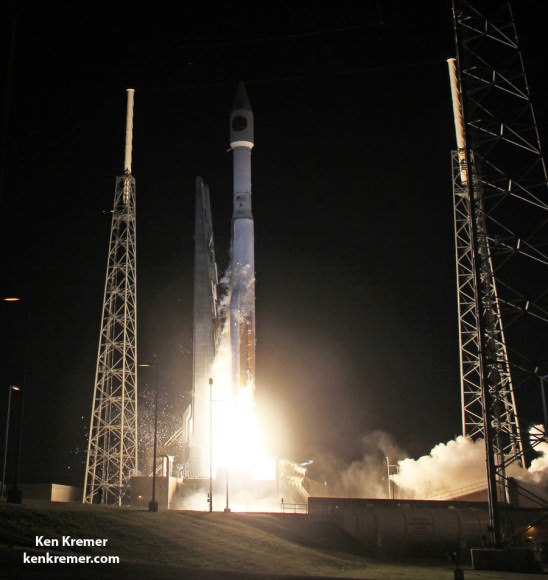
A United Launch Alliance Atlas V rocket with NASA’s Magnetospheric Multiscale (MMS) spacecraft onboard launches from the Cape Canaveral Air Force Station Space Launch Complex 41, Thursday, March 12, 2015, Florida. Credit: Ken Kremer- kenkremer.com
ULA’s most recent launch for NASA involved the $1.1 Billion Magnetospheric Multiscale (MMS) mission comprised of four formation flying satellites which blasted to Earth orbit atop an Atlas V rocket from Cape Canaveral Air Force Station, Florida, during a spectacular nighttime blastoff on March 12, 2015. Read my onsite reports – here and here.
“Space launch affects everyone, every day, and our goal in letting America name its next rocket is to help all Americans imagine the future of endless possibilities created by affordable space launch,” Bruno added.
NGLS will include some heritage design from the Atlas V and Delta IV rockets, but will feature many new systems and potentially some reusable systems – to be outlined by Bruno on April 13.
ULA plans to phase out the Delta IV around 2019 when the current contracts are concluded. The Atlas V will continue for a transitional period.
The Atlas V is also the launcher for Boeing’s CST-100 manned space taxi due to first launch in 2017.
NGLS will launch from Space Launch Complex-41 at Cape Canaveral Air Force Station, Florida, the same pad as for the Atlas V, as well as from Vandenberg AFB, Calif.
ULA’s next Delta IV launch with GPS IIF-9 is scheduled shortly for Wednesday, March 25, with liftoff at 2:36 p.m. EDT from Cape Canaveral.
Live webcast begins at 2:06 p.m. Live link here – http://www.ulalaunch.com/webcast.aspx
Vote now!
Stay tuned here for Ken’s continuing Earth and planetary science and human spaceflight news.
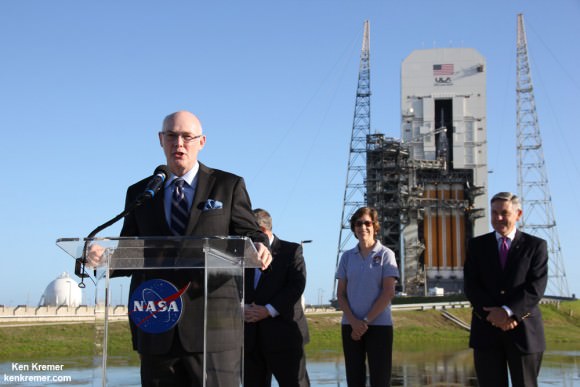
How Long Does It Take to Get to Pluto?
It’s a long way out to the dwarf planet Pluto. So, just how fast could we get there?
Pluto, the Dwarf planet, is an incomprehensibly long distance away. Seriously, it’s currently more than 5 billion kilometers away from Earth. It challenges the imagination that anyone could ever travel that kind of distance, and yet, NASA’s New Horizons has been making the journey, and it’s going to arrive there July, 2015.
You may have just heard about this news. And I promise you, when New Horizons makes its close encounter, it’s going to be everywhere. So let me give you the advanced knowledge on just how amazing this journey is, and what it would take to cross this enormous gulf in the Solar System.
Pluto travels on a highly elliptical orbit around the Sun. At its closest point, known as “perihelion”, Pluto is only 4.4 billion kilometers out. That’s nearly 30 AU, or 30 times the distance from the Earth to the Sun. Pluto last reached this point on September 5th, 1989. At its most distant point, known as “aphelion”, Pluto reaches a distance of 7.3 billion kilometers, or 49 AU. This will happen on August 23, 2113.
I know, these numbers seem incomprehensible and lose their meaning. So let me give you some context. Light itself takes 4.6 hours to travel from the Earth to Pluto. If you wanted to send a signal to Pluto, it would take 4.6 hours for your transmission to reach Pluto, and then an additional 4.6 hours for their message to return to us.
Let’s talk spacecraft. When New Horizons blasted off from Earth, it was going 58,000 km/h. Just for comparison, astronauts in orbit are merely jaunting along at 28,000 km/h. That’s its speed going away from the Earth. When you add up the speed of the Earth, New Horizons was moving away from the Sun at a blistering 160,000 km/h.
Unfortunately, the pull of gravity from the Sun slowed New Horizons down. By the time it reached Jupiter, it was only going 68,000 km/h. It was able to steal a little velocity from Jupiter and crank its speed back up to 83,000 km/h. When it finally reaches Pluto, it’ll be going about 50,000 km/h. So how long did this journey take?

New Horizons launched on January 19, 2006, and it’ll reach Pluto on July 14, 2015. Do a little math and you’ll find that it has taken 9 years, 5 months and 25 days. The Voyager spacecraft did the distance between Earth and Pluto in about 12.5 years, although, neither spacecraft actually flew past Pluto. And the Pioneer spacecraft completed the journey in about 11 years.
Could you get to Pluto faster? Absolutely. With a more powerful rocket, and a lighter spacecraft payload, you could definitely shave down the flight time. But there are a couple of problems. Rockets are expensive, coincidentally bigger rockets are super expensive. The other problem is that getting to Pluto faster means that it’s harder to do any kind of science once you reach the dwarf planet.
New Horizons made the fastest journey to Pluto, but it’s also going to fly past the planet at 50,000 km/h. That’s less time to take high resolution images. And if you wanted to actually go into orbit around Pluto, you’d need more rockets to lose all that velocity. So how long does it take to get to Pluto? Roughly 9-12 years. You could probably get there faster, but then you’d get less science done, and it probably wouldn’t be worth the rush.
Are you super excited about the New Horizons flyby of Pluto? Tell us all about it in the comments below.
How Far Back Are We Looking in Time?
When we look out into space, we’re also looking back into time. Just how far back can we see?
The Universe is a magic time window, allowing us to peer into the past. The further out we look, the further back in time we see. Despite our brains telling us things we see happen at the instant we view them, light moves at a mere 300,000 kilometers per second, which makes for a really weird time delay at great distances.
Let’s say that you’re talking with a friend who’s about a meter away. The light from your friend’s face took about 3.336 nanoseconds to reach you. You’re always seeing your loved ones 3.336 nanoseconds into the past. When you look around you, you’re not seeing the world as it is, you’re seeing the world as it was, a fraction of a second ago. And the further things are, the further back in time you’re looking.
The distance to the Moon is, on average, about 384,000 km. Light takes about 1.28 seconds to get from the Moon to the Earth. If there was a large explosion on the Moon of a secret Nazi base, you wouldn’t see it for just over a second. Even trying to communicate with someone on the Moon would be frustrating as you’d experience a delay each time you talked.
Let’s go with some larger examples. Our Sun is 8 minutes and 20 seconds away at the speed of light. You’re not seeing the Sun as it is, but how it looked more than 8 minutes ago.
On average, Mars is about 14 light minutes away from Earth. When we were watching live coverage of NASA’s Curiosity Rover landing on Mars, it wasn’t live. Curiosity landed minutes earlier, and we had to wait for the radio signals to reach us, since they travel at the speed of light.
When NASA’s New Horizons spacecraft reaches Pluto next year, it’ll be 4.6 light hours away. If we had a telescope strong enough to watch the close encounter, we’d be looking at events that happened 4.6 hours ago.
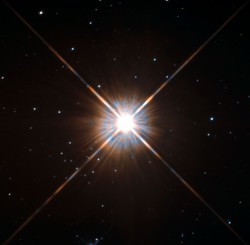
The closest star, Proxima Centauri, is more than 4.2 light-years away. This means that the Proxima Centurans don’t know who won the last US Election, or that there are going to be new Star Wars movies. They will, however, as of when this video was produced, be watching Toronto make some questionable life choices regarding its mayoral election.
The Eagle Nebula with the famous Pillars of Creation, is 7,000 light-years away. Astronomers believe that a supernova has already gone off in this region, blasting them away. Take a picture with a telescope and you’ll see them, but mostly likely they’ve been gone for thousands of years.
The core of our own Milky Way galaxy is about 25,000 light-years away. When you look at these beautiful pictures of the core of the Milky Way, you’re seeing light that may well have left before humans first settled in North America.
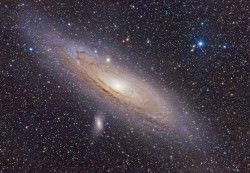
And don’t get me started on Andromeda. That galaxy is more than 2.5 million light-years away. That light left Andromeda before we had Homo Erectus on Earth. There are galaxies out there, where aliens with powerful enough telescopes could be watching dinosaurs roaming the Earth, right now.
Here’s where it gets even more interesting. Some of the brightest objects in the sky are quasars, actively feeding supermassive black holes at the cores of galaxies. The closest is 2.5 billion light years away, but there are many much further out. Earth formed only 4.5 billion years ago, so we can see quasars shining where the light had left before the Earth even formed.
The Cosmic Microwave Background Radiation, the very edge of the observable Universe is about 13.8 billion light-years away. This light left the Universe when it was only a few hundred thousand years old, and only now has finally reached us. What’s even stranger, the place that emitted that radiation is now 46 billion light-years away from us.
So crack out your sonic screwdrivers and enjoy your time machine, Whovians. Your ability to look out into space and peer into the past. Without a finite speed of light, we wouldn’t know as much about the Universe we live in and where we came from. What moment in history do you wish you could watch? Express your answer in the form of a distance in light-years.
Weekly Space Hangout – February 20, 2015 – Charles Black from SEN
Host: Fraser Cain (@fcain)
Guests:
Ramin Skibba (@raminskibba)
Dave Dickinson (@astroguyz / www.astroguyz.com)
Special Guest: Charles Black (@charlesblack / sen.com/charles-black)
Continue reading “Weekly Space Hangout – February 20, 2015 – Charles Black from SEN”
New Horizons Now Close Enough to See Pluto’s Smaller Moons
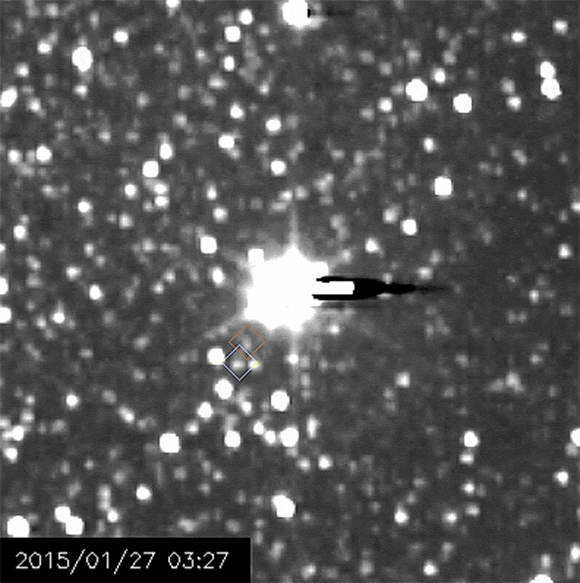
Now on the final leg of its journey to distant Pluto the New Horizons spacecraft has been able to spot not only the dwarf planet and its largest moon Charon, but also two of its much smaller moons, Hydra and Nix – the latter for the very first time!
The animation above comprises seven frames made of images acquired by New Horizons from Jan. 27 to Feb. 8, 2015 while the spacecraft was closing in on 115 million miles (186 million km) from Pluto. Hydra is noted by a yellow box and Nix is in the orange. (See a version of the animation with some of the background stars and noise cleared out here.)
What’s more, these images have been released on the 85th anniversary of the first spotting of Pluto by Clyde Tombaugh at the Lowell Observatory in Flagstaff, AZ.
“Professor Tombaugh’s discovery of Pluto was far ahead its time, heralding the discovery of the Kuiper Belt and a new class of planet. The New Horizons team salutes his historic accomplishment.”
– Alan Stern, New Horizons PI, Southwest Research Institute
Launched Jan. 19, 2006, New Horizons will make its closest pass of Pluto and Charon on July 14 of this year. It is currently 32.39 AU from Earth – over 4.84 billion kilometers away.
“It’s thrilling to watch the details of the Pluto system emerge as we close the distance to the spacecraft’s July 14 encounter,” said New Horizons science team member John Spencer from the Southwest Research Institute (SwRI). “This first good view of Nix and Hydra marks another major milestone, and a perfect way to celebrate the anniversary of Pluto’s discovery.”
Along with the distance between Earth and Pluto, New Horizons is also bridging the gap of history: a portion of Mr. Tombaugh’s ashes are being carried aboard the spacecraft, as well as several historic mementos.
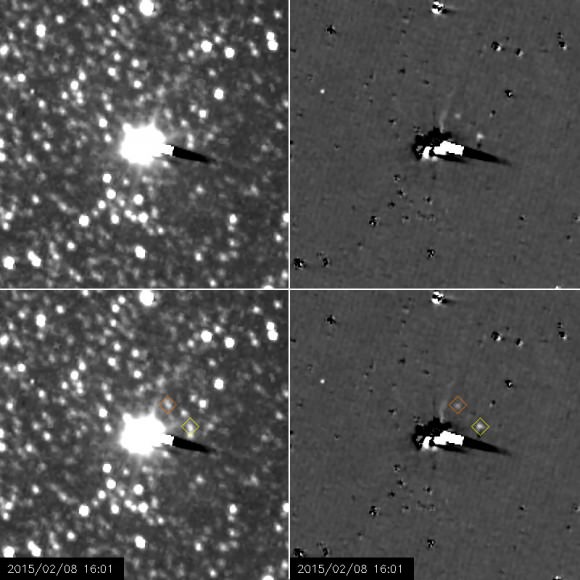
Each frame in the animation is a combination of five 10-second images taken with New Horizons’ Long-Range Reconnaissance Imager (LORRI) using a special mode that increases sensitivity at the expense of resolution. Celestial north is inclined 28 degrees clockwise from the “up” direction in these images.
The dark streaks are a result of overexposure on the digital camera’s sensitive detector.
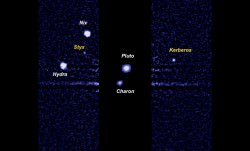
Pluto has a total of five known moons: Charon, Hydra, Nix, Styx, and Kerberos. Pluto and Charon are within the glare of the image exposures and can’t be resolved separately, and Styx and Kerberos are too dim to be detected yet. But Hydra and Nix, each around 25–95 miles (40–150 km) in diameter, could be captured on camera.
More precise measurements of these moons’ sizes – and whether or not there may be even more satellites in the Pluto system – will be determined as New Horizons approaches its July flyby date.
Learn more about the New Horizons mission here.
Source: NASA
The Moment We’ve been Waiting For: First New Images of Pluto from New Horizons
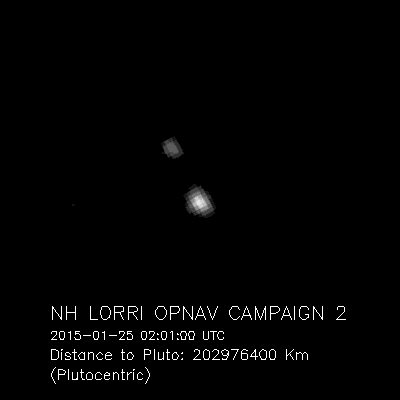
Here we go! New Horizons is now on approach and today – on the anniversary of Pluto discoverer Clyde Tombaugh’s birth – the spacecraft has sent back its first new images of the Pluto system. The images aren’t Earth-shattering (Pluto-shattering?) but they do represent the mission is closing in on its target, and will allow the New Horizons engineers to precisely aim the spacecraft as it continues its approach.
The photos were taken with the telescopic Long-Range Reconnaissance Imager (LORRI) on January 25 and 27, 2015.
“Pluto is finally becoming more than just a pinpoint of light,” said Hal Weaver, New Horizons project scientist. “LORRI has now resolved Pluto, and the dwarf planet will continue to grow larger and larger in the images as New Horizons spacecraft hurtles toward its targets. The new LORRI images also demonstrate that the camera’s performance is unchanged since it was launched more than nine years ago.”
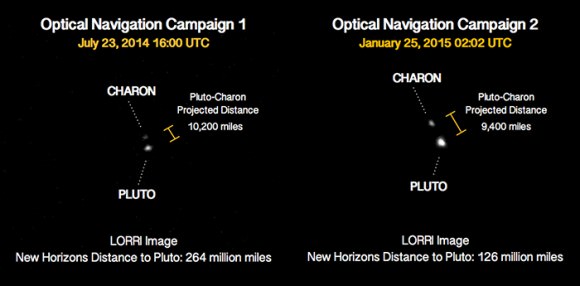
New Horizons was about 203 million kilometers (126 million miles) away from Pluto when it began taking images. Pluto appears as a pixelated smudge, and New Horizons is only close enough so that just Pluto and its largest moon, Charon are visible. In this current view from LORRI, Pluto is about 2 pixels and Charon is 1, compared to 1 pixel and 0.5 pixels last July. The images were magnified four times to make Pluto and Charon more visible.
NASA says that over the next few months, LORRI will take hundreds of pictures of Pluto, against a starry backdrop, to refine the team’s estimates of New Horizons’ distance to Pluto. As in these first images, the Pluto system will resemble little more than bright dots in the camera’s view until late spring. However, mission navigators can still use such images to design course-correcting engine maneuvers to direct the spacecraft for a more precise approach. The first such maneuver based on these optical navigation images, or OpNavs, is scheduled for March 10.
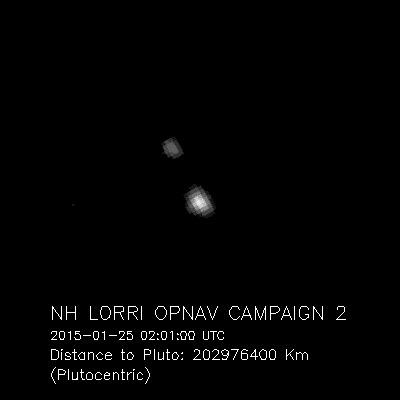
Image Credit:
NASA/JHU APL/SwRI
Closest approach for the spacecraft will be on July 14.
These first images represent a milestone.
“These images of Pluto, clearly brighter and closer than those New Horizons took last July from twice as far away, represent our first steps at turning the pinpoint of light Clyde saw in the telescopes at Lowell Observatory 85 years ago, into a planet before the eyes of the world this summer,” said Alan Stern, New Horizons principal investigator. “This is our birthday tribute to Professor Tombaugh and the Tombaugh family, in honor of his discovery and life achievements — which truly became a harbinger of 21st century planetary astronomy.”
During its flyby, New Horizons will be characterizing the global geology and topography of Pluto and Charon, mapping their surface compositions and temperatures, examining Pluto’s atmospheric composition and structure, studying Pluto’s smaller moons, and searching for new moons and rings.
Weekly Space Hangout – Jan. 23, 2015: SpaceX, Rosetta, and Asteroid Updates!
Host: Fraser Cain (@fcain)
Guests:
Morgan Rehnberg (cosmicchatter.org / @MorganRehnberg )
Ramin Skibba (@raminskibba)
Dave Dickinson (@astroguyz / www.astroguyz.com)
Continue reading “Weekly Space Hangout – Jan. 23, 2015: SpaceX, Rosetta, and Asteroid Updates!”
Most Powerful Atlas V Delivers a Most Spectacular Nighttime Sky Show Launch for US Navy
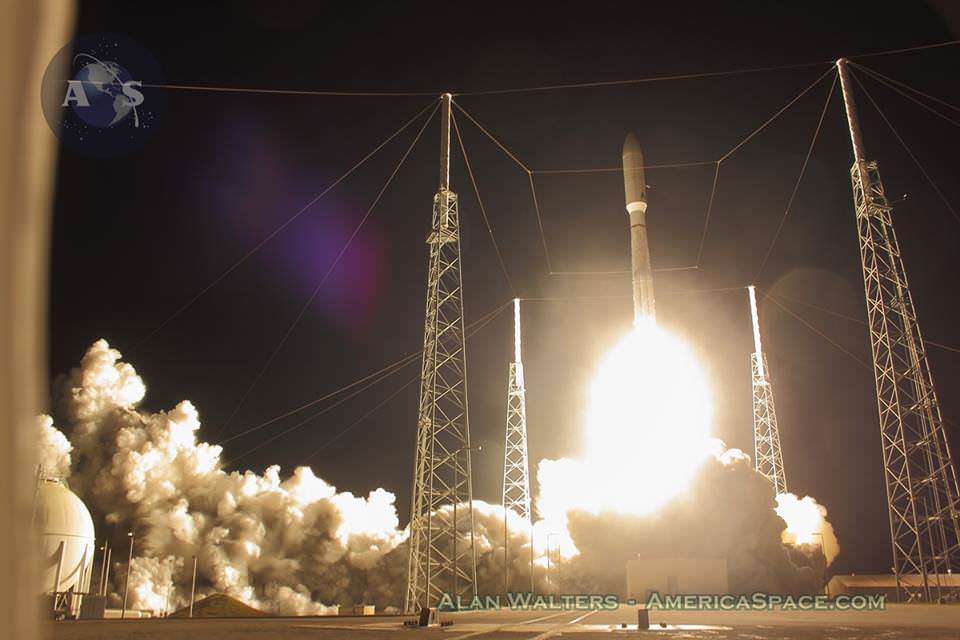
Blastoff of ULA Atlas V rocket lofting MUOS-3 to orbit for the US Navy from Space Launch Complex-41 at 8:04 p.m. EST on Jan. 20, 2015. Credit: Alan Walters/AmericaSpace
See launch gallery below![/caption]
Launching on its milestone 200th mission, the most powerful version of the venerable Atlas-Centaur rocket put on a most spectacular nighttime sky show on Tuesday evening, (Jan. 20) that mesmerized spectators along the Florida Space Coast on a mission to deliver a powerful new next-generation communications satellite to orbit for the US Navy.
The United Launch Alliance (ULA) Atlas V rocket carrying the third Mobile User Objective System satellite (MUOS-3) for the United States Navy successfully launched to geostationary orbit from Space Launch Complex-41 at 8:04 p.m. EST from Cape Canaveral Air Force Station, Florida on Jan. 20, 2015.
The MUOS-3 launch opened ULA’s planned 13 mission manifest for 2015 with a boisterous bang as the Atlas V booster thundered off the seaside space coast pad.
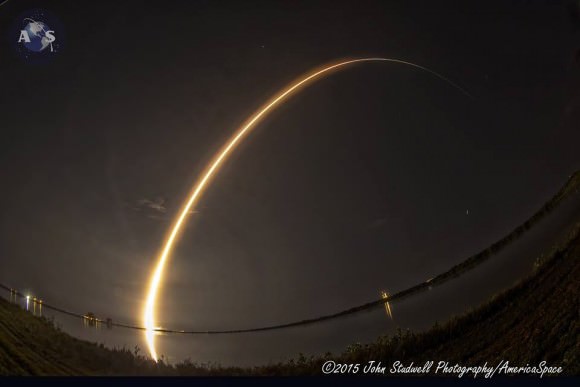
The MUOS constellation is a next-generation narrowband US Navy tactical satellite communications system designed to significantly improve ground communications to US forces on the move and around the globe.
“The ULA team is honored to deliver this critical mission into orbit for the U.S. Navy and U.S. Air Force with the support of our many mission partners,” said Jim Sponnick, ULA vice president, Atlas and Delta Programs.
This is the third satellite in the MUOS series and will provide military users 10 times more communications capability over existing systems, including simultaneous voice, video and data, leveraging 3G mobile communications technology. It was built by Lockheed Martin.
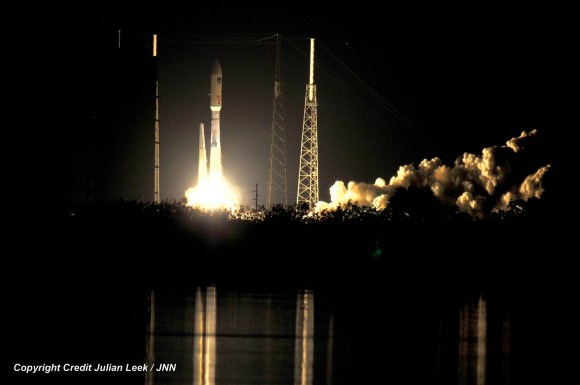
The unmanned Atlas V expendable rocket launched in its mightiest configuration known as the Atlas V 551.
The 206 foot-tall rocket features a 5-meter diameter payload fairing, five Aerojet Rocketdyne first stage strap on solid rocket motors and a single engine Centaur upper stage powered by the Aerojet Rocketdyne RL10C-1 engine.
The first stage is powered by the Russian-built dual nozzle RD AMROSS RD-180 engine. Combined with the five solid rocket motors, the Atlas V first stage generates over 2.5 million pounds of liftoff thrust.
The RD-180 burns RP-1 (Rocket Propellant-1 or highly purified kerosene) and liquid oxygen and delivers 860,200 lb of thrust at sea level.
And the rocket needed all that thrust because the huge MUOS-3 was the heftiest payload lofted by an Atlas V booster, weighing in at some 15,000 pounds.
“The MUOS-3 spacecraft is the heaviest payload to launch atop an Atlas V launch vehicle. The Atlas V generated more than two and half million pounds of thrust at liftoff to meet the demands of lifting this nearly 7.5-ton satellite,” noted Sponnick.
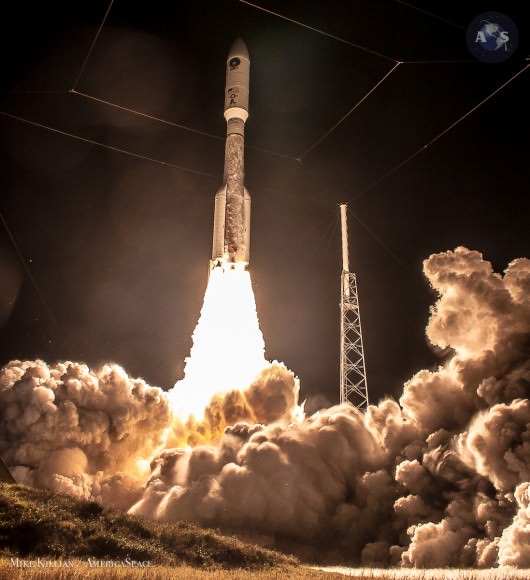
The first Atlas rocket was first launched some 52 years ago.
“Today’s launch was the 200th Atlas-Centaur launch – a very sincere congratulations to the many women and men responsible for the incredible success of the Centaur upper stage over the last 5 decades!”
Overall this was the 52nd Atlas V mission and the fifth in the Atlas V 551 configuration.
The Atlas V 551 version has previously launched two prominent NASA planetary science missions including the New Horizons mission in 2006 that is about to reach Pluto and the Juno orbiter in 2011 that will arrive at Jupiter in July 2016. It was also used to launch MUOS-1 and MUOS-2.
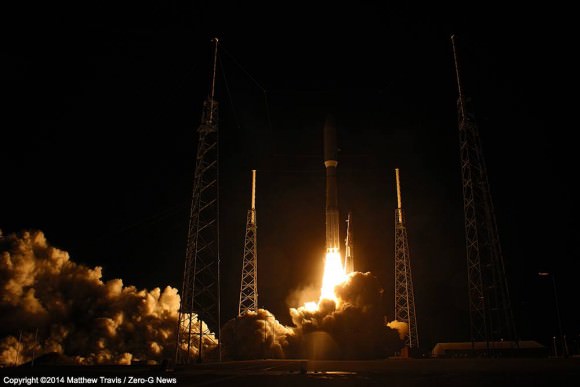
ULA’s second launch in 2015 thunders aloft from the US West Coast with NASA’s Soil Moisture Active Passive mission (SMAP) next week.
SMAP is the first US Earth-observing satellite designed to collect global observations of surface soil moisture.
SMAP will blastoff from Space Launch Complex 2 at Vandenberg AFB at 9:20 a.m. EST (6:20 a.m. PST) on ULA’s Delta II rocket.
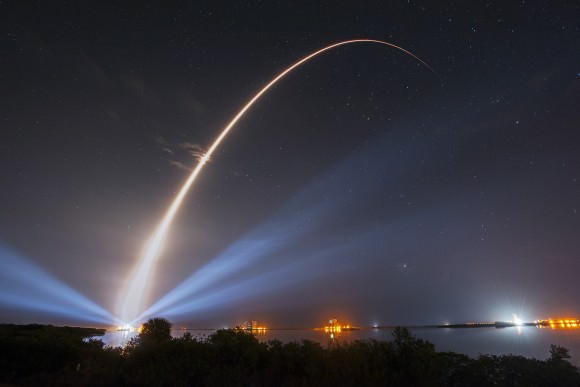
In another major milestone coming soon, the Atlas V is right now being man rated since it was chosen to launch the Boeing CST-100 space taxi, which NASA selected as one of two new commercial crew vehicles to launch US astronauts to the ISS as soon as 2017.
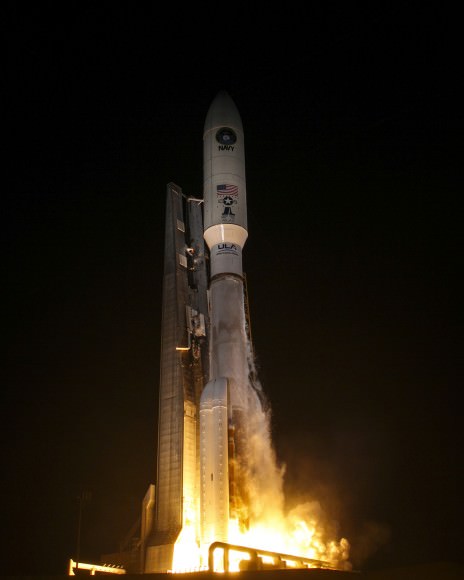
The next Atlas launch involves NASA’s Magnetospheric Multiscale Mission (MMS) to study Earth’s magnetic reconnection. It is scheduled for launch on an Atlas V 421 booster on March 12 from Cape Canaveral. See my up close visit with MMS and NASA Administrator Charles Bolden at NASA Goddard Space Flight Center detailed in my story – here.
Stay tuned here for Ken’s continuing Earth and planetary science and human spaceflight news.




